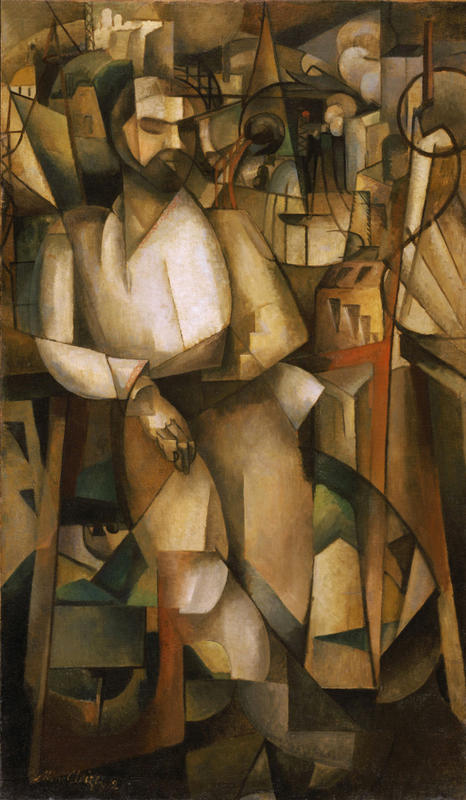More about Man on a Balcony

Contributor
Of all the cubist artwork that exists, Man on a Balcony is arguably one of the more vanilla pieces of the genre.
But that has actually turned out to be a good thing, as this piece was used to introduce the rule-breaking style to the general public. It's important to remember that at one point works like these were the forefront of abstract art.
Albert Gleizes did not invent cubism; Picasso is typically the one credited with that step. However, at least for the first few years, Picasso’s dealer would not let the artist put his cubist work where anyone could see it. Even though they are famous and respected works of art now, people back then had a habit of making fun of pieces like Three Musicians, and as a result neither salon owners or dealers wanted them in public spaces.
The task of bringing this kind of work into the light was left to men like Albert Gleizes, and they could not have found a better man for the job. Albert Gleizes is not just a reasonable cubist (i.e., you can understand what he is painting) but an intentional one. Albert and his friend Jean Metzinger literally wrote the book on the style, "Du Cubisme," which sought to show that not only was the art style respectable, but also touched on all of the artistic, psychological, and mathematical ideas behind it.
Unfortunately, it wasn’t enough. The display of Albert Gleizes' work actually produced a huge national scandal in France. People called the work incomprehensible and absurd. However, with time and the tactical application of Albert’s book, the public came to accept the art movement. Now nearly a hundred years later it is respected as a cornerstone of abstract art.
Sources
- Cottington, David “Cubism and Its Histories” Manchester University Press 2004 pg 137 https://books.google.com/books?id=KFGgxn7lfq0C&pg=PA137&lpg=PA137&dq=cu…
- Philadelphia Museum of Art “Picasso Posse: Reasonable Cubism” Youtube.com 03/09/2010 https://www.youtube.com/watch?v=QJh3DxGHlKs
- Web Contributor "Albert Gleizes." Oxford Reference viewed 10/16/2019. https://www.oxfordreference.com/view/10.1093/oi/authority.2011081010500…
- Web Contributor “Cubism History” History.com 10/16/2019 https://www.history.com/topics/art-history/history-of-cubism
Featured Content
Here is what Wikipedia says about Man on a Balcony
Man on a Balcony (also known as Portrait of Dr. Théo Morinaud and 'L'Homme au balcon), is a large oil painting created in 1912 by the French artist, theorist and writer Albert Gleizes (1881–1953). The painting was exhibited in Paris at the Salon d'Automne of 1912 (no. 689). The Cubist contribution to the salon created a controversy in the French Parliament about the use of public funds to provide the venue for such 'barbaric art'. Gleizes was a founder of Cubism, and demonstrates the principles of the movement in this monumental painting (over six feet tall) with its projecting planes and fragmented lines. The large size of the painting reflects Gleizes's ambition to show it in the large annual salon exhibitions in Paris, where he was able with others of his entourage to bring Cubism to wider audiences.
In February 1913, Gleizes and other artists introduced the new style of modern art known as Cubism to an American audience at the Armory Show in New York City, Chicago and Boston. In addition to Man on a balcony (no. 196), Gleizes exhibited his 1910 painting Femme aux Phlox (Museum of Fine Arts, Houston).
Man on a Balcony was reproduced in L'Excelsior, Au Salon d'Automne, Les Indépendants, 2 October 1912. It was then reproduced in Les Peintres Cubistes, Méditations Esthétiques, a collection of essays by Guillaume Apollinaire published in 1913 The painting was completed around the same time as Albert Gleizes co-authored with Jean Metzinger a major treatise titled Du "Cubisme" (the first and only manifesto on Cubism). Man on a Balcony was purchased at the 1913 Armory Show by the lawyer, author, art critic, private art collector, and American proponent of Cubism Arthur Jerome Eddy for $540. Gleizes' Man on a Balcony was the frontispiece of Arthur Jerome Eddy's book Cubists and Post-Impressionism, March 1914. The painting later formed part of the Louise and Walter Conrad Arensberg Collection, 1950. It is currently in the permanent collection of the Philadelphia Museum of Art.

Check out the full Wikipedia article about Man on a Balcony












